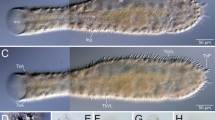Summary
The filamentous cytoskeletons of epidermal cells of the bullfrog (Rana catesbeiana) were investigated by electron microscopy. Following treatment with trypsin, sheets of epithelium were removed from swatches of abdominal skin. Trypsinization produces differential effects on the ultrastructure of the various cell layers. The desmosomes of all layers, except those of the stratum corneum, are split by trypsinization and the resulting desmosomal plaques fastened to tonofilaments are retracted into cells to form deep “inpouchings” of the plasma membranes, while tonofilament bundles become diffuse. Epidermal sheets were gently homogenized to form a suspension of cell remnants with damaged plasma membranes as indicated by vital dye exclusion tests and electron microscopy. Cytoskeletons retain their shapes, yet the lateral distances between individual tonofilaments within bundles appear to increase, thus forming diffuse lacelike structures. These observations support the suggestion that tonofilament bundles, when fastened to desmosomes, have elastic properties. The possible role of the cytoskeletons in the maintenance of cell size and shape in an ion-transporting epithelium is discussed.
Similar content being viewed by others
References
Brody, I.: The ultrastructure of the tonofibrils in the keratinization process of normal human epidermis. J. Ultrastruct. Res. 4, 264–297 (1960)
Campbell, R.D., Campbell, J.H.: Origin and continuity of desmosomes. In: Origin and continuity of cell organelles. (J. Reinert and H. Ursprung, eds.). New York: Springer-Verlag 1971
Carasso, N., Favard, P., Jard, S., Rajerison, R.M.: The isolated frog epithelium. I. Preparation and general structure in different physiological states. J. Microsc. 10, 315–330 (1971)
Cerejido, M., Rotunno, C.A.: Fluxes and distribution of sodium in frog skin: a new model. J. Gen. Physiol. 51, 280–289 (1968)
Charles, A., Smiddy, F.G.: The tonofibrils of the human epidermis. J. Invest. Dermatol. 29, 327–338 (1957)
Eggena, P.: Action of vasopressin, ouabain, and cyanide on the volume of isolated toad bladder epithelial cells. J. Membr. Biol. 35, 29–37 (1977)
Farquhar, M.G., Palade, G.E.: Functional organization of amphibian skin. Proc. Nat. Acad. Sci. 51, 569–577 (1964)
Farquhar, M.G., Palade, G.E.: Cell junctions in amphibian skin. J. Cell Biol. 26, 263–291 (1965)
Farquhar, M.G., Palade, G.E.: Adenosine triphosphate localization in amphibian epidermis. J. Cell Biol. 30, 359–379 (1966)
Gray, G.M., Yardley, H.J.: Mitochondria and nuclei of pig and human epidermis: isolation and lipid composition. J. Invest. Dermatol. 64, 422–430 (1975)
Gray, G.M., Yardley, H.J.: Brittle fracture of epidermal cells by liquid-shear. J. Cell Sci. 20, 699–705 (1976)
Kaltenbach, J.P., Kaltenbach, M.H., Lyons, W.B.: Nigrosin as a dye for differentiating live and dead ascites cells. Exp. Cell Res. 15, 112–117 (1958)
Kelly, D.E.: Fine structure of desmosomes, hemidesmosomes and an adepidermal globular layer in developing newt epidermis. J. Cell Biol. 28, 51–72 (1966)
Koefoed-Johnsen, V., Ussing, H.H.: The nature of the frog skin potential. Acta Physiol. Scand. 42, 298–308 (1958)
Kunitz, M.: Crystalline soybean trypsin inhibitor. II. General properties. J. Gen. Physiol. 30, 291–310 (1947a)
Kunitz, M.: Isolation of a crystalline protein compound of trypsin and of soybean trypsin-inhibitor. J. Gen. Physiol. 30, 311–320 (1947b)
Listgarten, M.A.: The ultrastructure of human gingival epithelium. Amer. J. Anat. 114, 49–69 (1964)
Manger, R.L., Pratley, J.N.: Some properties of frog skin epithelial tonofilaments. J. Cell Biol. 75, No. 2, Pt. 2, 363a (1977)
McNutt, N.S., Weinstein, R.S.: Membrane ultrastructure at mammalian intercellular junctions. Prog. Biophys. Mol. Biol. 26, 45–101 (1973)
Odland, G.F.: Tonofilaments and keratohyalin. In: The epidermis (W. Montagna and W.C. Lobitz, eds.) New York: Academic Press 1964
Overton, J.: Desmosome development in normal and reassociated cells in early chick blastoderm. Dev. Biol. 4, 532–548 (1962)
Overton, J.: The fate of desmosomes in trypsinized tissue. J. Exp. Zool. 168, 203–214 (1968)
Parakkal, P.F., Alexander, N.J.: Keratinization: A survey of vertebrate epithelia. New York: Academic Press 1972
Parakkal, P.F., Matoltsy, A.G.: A study of the fine structure of the epidermis of Rana pipiens. J. Cell Biol. 20, 85–94 (1964)
Pratley, J.N., McQuillen, N.K.: The role of microfilaments in frog skin ion transport. J. Cell Biol. 56, 850–857 (1973)
Skerrow, C.J., Matoltsy, A.G.: Isolation of epidermal desmosomes. J. Cell Biol. 63, 515–523 (1974)
Spearman, R.I.: The integument: A textbook of skin biology. Cambridge: The University Press 1973
Spring, K.R., Hope, A.: Size and shape of the lateral intercellular spaces in a living epithelium. Science 200, 54–58 (1978)
Ussing, H.U., Zerahn, K.: Active transport of sodium as the source of electric current in the short-circuited isolated frog skin. Acta Physiol. Scand. 23, 110–127 (1951)
Voute, C.L.: An electron microscopic study of the skin of the frog (Rana pipiens). J. Ultrastruct. Res. 9, 497–510 (1963)
Voute, C.L., Ussing, H.H.: The morphological aspects of a shunt path in the epithelium of the frog skin (Rana temporaria). Exp. Cell Res. 62, 375–383 (1970a)
Voute, C.L., Ussing, H.H.: Quantitative relation between hydrostatic pressure gradient, extracellular volume and active sodium transport in the epithelium of the frog skin (Rana temporaria) Exp. Cell Res. 62, 375–383 (1970b)
Wilgram, G., Caulfield, J.B., Madgic, E.B.: A possible role of the desmosome in the process of keratinization. In: The epidermis. (W. Montagna and W.C. Lobitz, eds.) London: Academic Press 1964
Wilgram, G., Caulfield, J.B., Madgic, E.B.: An electron microscopic study of genetic errors in keratinization in man. In: Biology of skin and hair growth. (A. Lyne and B. Short, eds.). Sidney: Angus and Robertson 1965
Yeltman, D.R.: Correlation of ultrastructure with bioelectric potentials in Rana pipiens epidermis. Master's thesis. California State University, San Jose (1971)
Zylber, E.A., Rotunno, C.A., Cereijido, M.: Ion and water balance in isolated epithelial cells of the abdominal skin of the frog Leptodoctylus ocellatus. J. Membr. Biol. 13, 199–216 (1973)
Author information
Authors and Affiliations
Additional information
This investigation was supported, in part, by United States Public Health Service Training Grant AH 01037-01
Rights and permissions
About this article
Cite this article
Morejohn, L.C., Pratley, J.N. Differential effects of trypsin on the epidermis of Rana catesbeiana . Cell Tissue Res. 198, 349–362 (1979). https://doi.org/10.1007/BF00232016
Accepted:
Issue Date:
DOI: https://doi.org/10.1007/BF00232016




